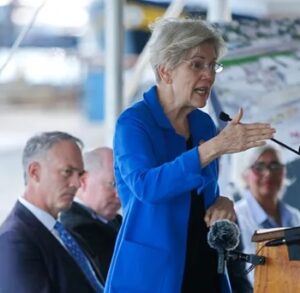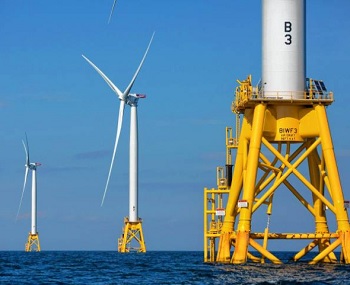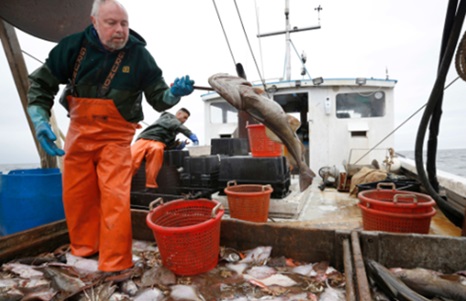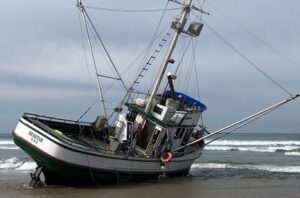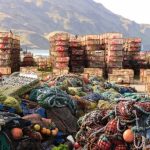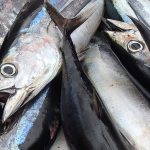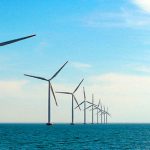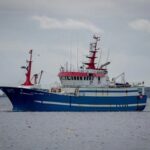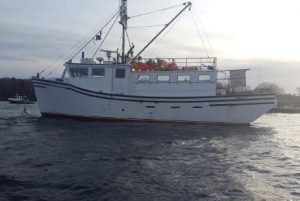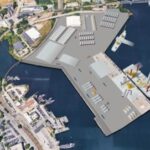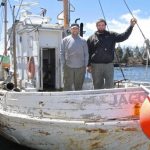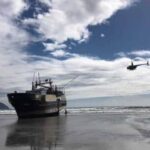Tag Archives: offshore wind
Exploring the impact of offshore wind on whale deaths
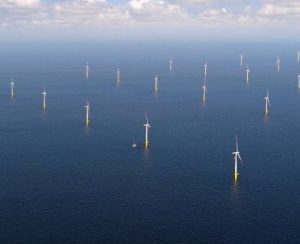 In the winter of 2022–2023, nearly a dozen whales died off the coast of New Jersey, near the sites of several proposed wind farms. Their deaths prompted concern that related survey work being conducted in the area somehow contributed to their deaths. The increased presence of these turbines in coastal waters, along with the noise from construction and surveys, has led to concerns of their impact on marine life. In particular, cetaceans such as whales and dolphins are likely to be sensitive to the noises and increased marine traffic brought by these turbines. However, the Marine Mammal Commission, a federal oversight agency, states there is no evidence linking the whales that died in the New Jersey region in the winter of 2022–2023 to wind energy development. more, >>CLICK TO READ<< 10:35
In the winter of 2022–2023, nearly a dozen whales died off the coast of New Jersey, near the sites of several proposed wind farms. Their deaths prompted concern that related survey work being conducted in the area somehow contributed to their deaths. The increased presence of these turbines in coastal waters, along with the noise from construction and surveys, has led to concerns of their impact on marine life. In particular, cetaceans such as whales and dolphins are likely to be sensitive to the noises and increased marine traffic brought by these turbines. However, the Marine Mammal Commission, a federal oversight agency, states there is no evidence linking the whales that died in the New Jersey region in the winter of 2022–2023 to wind energy development. more, >>CLICK TO READ<< 10:35
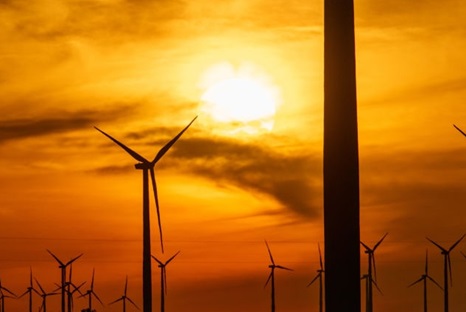
Donald Trump Pledges to Halt Big Wind Subsidies
Donald Trump’s election victory is quickly taking the wind out of the Biden administration’s ambitious renewables initiatives. President-elect Trump promised to end federal subsidies for offshore wind projects on his first day in office. As with many of his campaign pledges, Americans wait to see whether he will deliver. However, the market did not wait to see. Stock prices of offshore wind developers and turbine makers moved sharply downward following election day as investors query whether windmill projects are economically viable without the hefty federal subsidies Trump has promised to terminate. Environmental groups and fishermen have also raised concerns about the potential ecological trade-offs of this plastic-based technology and worries about ecotoxins created in the manufacturing of solar panels and EVs have caused consumers to pause. more, >>CLICK TO READ<< 10:22
Fishermen, fleet owners hope Trump helps their industry
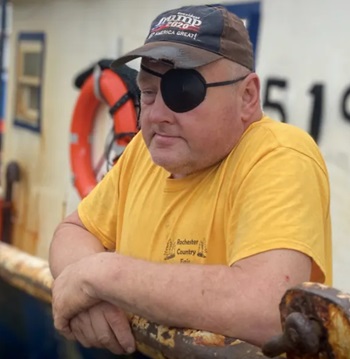 New Bedford fishermen fly many flags. There is the American flag, the skull and crossbones flag. There are flags expressing resistance to offshore wind development. And there are many — many — flags for former President Donald Trump. But one flag is rarely hoisted on the New Bedford waterfront. “I have yet to see a Harris-Walz flag on a fishing vessel,” said Drew Minkiewicz, an attorney representing the industry’s Sustainable Scalloping Fund. The vast support for Trump among fishermen boils down to a few main points, some specific to the fishing industry, some not. Trump has said that he would overturn the ban on commercial fishing in Marine National Monuments, which was first enacted by the Obama administration, repealed by Trump and then re-established under President Joe Biden. There are frustrations with immigration policy and with inflation, especially with gas and food, which have an acute impact on the profits of a fishing trip. But no issue has swayed the politics of the fishing industry more than offshore wind development. more, >>CLICK TO READ<< 18:50
New Bedford fishermen fly many flags. There is the American flag, the skull and crossbones flag. There are flags expressing resistance to offshore wind development. And there are many — many — flags for former President Donald Trump. But one flag is rarely hoisted on the New Bedford waterfront. “I have yet to see a Harris-Walz flag on a fishing vessel,” said Drew Minkiewicz, an attorney representing the industry’s Sustainable Scalloping Fund. The vast support for Trump among fishermen boils down to a few main points, some specific to the fishing industry, some not. Trump has said that he would overturn the ban on commercial fishing in Marine National Monuments, which was first enacted by the Obama administration, repealed by Trump and then re-established under President Joe Biden. There are frustrations with immigration policy and with inflation, especially with gas and food, which have an acute impact on the profits of a fishing trip. But no issue has swayed the politics of the fishing industry more than offshore wind development. more, >>CLICK TO READ<< 18:50
Why are we so fixated on offshore wind?
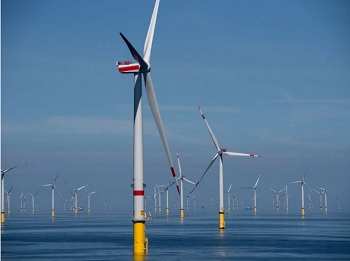 As we await the finalization of Gov. Maura Healey’s new offshore wind contracts, the Massachusetts Interagency Offshore Wind Council has requested public comments on these plans to implement offshore wind in Massachusetts. Many residents, especially from Cape Cod, have registered strong opposition. Eco-Nuclear Solutions is concerned that the reliance on offshore wind will deprive the Commonwealth of more reliable, affordable, and ecologically acceptable sources of electricity. There are also still many unanswered questions about offshore wind. Construction costs have massively increased, and we seem captured by this one technology. Why aren’t we assessing other energy solutions? When will we know the total costs, including transmission and delivery, of offshore wind and the total amount of subsidies? more, >>CLICK TO READ<< 09:48
As we await the finalization of Gov. Maura Healey’s new offshore wind contracts, the Massachusetts Interagency Offshore Wind Council has requested public comments on these plans to implement offshore wind in Massachusetts. Many residents, especially from Cape Cod, have registered strong opposition. Eco-Nuclear Solutions is concerned that the reliance on offshore wind will deprive the Commonwealth of more reliable, affordable, and ecologically acceptable sources of electricity. There are also still many unanswered questions about offshore wind. Construction costs have massively increased, and we seem captured by this one technology. Why aren’t we assessing other energy solutions? When will we know the total costs, including transmission and delivery, of offshore wind and the total amount of subsidies? more, >>CLICK TO READ<< 09:48
Offshore wind looked like a sure thing for Oregon — until it wasn’t.
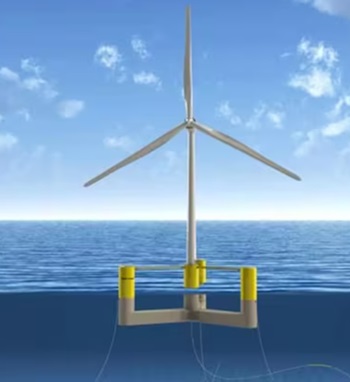 A push to bring floating offshore wind technology to the Southern Oregon coast was gaining momentum. The Oregon Department of Energy saw floating offshore wind playing a critical role in the state’s, and the region’s renewable energy goals. The Biden administration had ambitious national goals for developing offshore wind, and the Oregon Coast played a key role. For the U.S. Department of Interior’s Bureau of Ocean Energy Management, or BOEM, the years-long process of identifying areas for development and selecting potential bidders to see if the technology would work off the coast was coming to a close. And then, in a single week in late September — after years of effort, and less than three weeks before BOEM officials expected to choose a company to develop offshore wind — everything fell apart. more, >>CLICK TO READ<< 13:09
A push to bring floating offshore wind technology to the Southern Oregon coast was gaining momentum. The Oregon Department of Energy saw floating offshore wind playing a critical role in the state’s, and the region’s renewable energy goals. The Biden administration had ambitious national goals for developing offshore wind, and the Oregon Coast played a key role. For the U.S. Department of Interior’s Bureau of Ocean Energy Management, or BOEM, the years-long process of identifying areas for development and selecting potential bidders to see if the technology would work off the coast was coming to a close. And then, in a single week in late September — after years of effort, and less than three weeks before BOEM officials expected to choose a company to develop offshore wind — everything fell apart. more, >>CLICK TO READ<< 13:09
Swinney gives commitment to ensure that fishing and offshore wind can co-exist
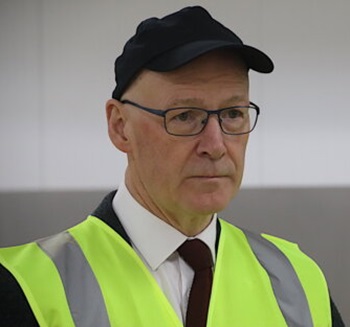 First minister John Swinney has given a commitment to ensuring the fishing industry and the offshore marine energy sector can exist together. It followed a stark warning by Elspeth Macdonald, the chief executive of the Scottish Fishermen’s Federation, that floating wind farms and the fishing sector are “simply not able to co-exist”. Speaking at last week’s SFF dinner, Macdonald call on the government to actively protect the fishing industry from the encroaching offshore wind industry. One example quoted by the industry is the proposed 500MW Stoura wind farm, 40 miles to east of Shetland, which could be built on top of prime fishing grounds for both the whitefish and the pelagic sector. Video, more, >>CLICK TO READ<< 06:47
First minister John Swinney has given a commitment to ensuring the fishing industry and the offshore marine energy sector can exist together. It followed a stark warning by Elspeth Macdonald, the chief executive of the Scottish Fishermen’s Federation, that floating wind farms and the fishing sector are “simply not able to co-exist”. Speaking at last week’s SFF dinner, Macdonald call on the government to actively protect the fishing industry from the encroaching offshore wind industry. One example quoted by the industry is the proposed 500MW Stoura wind farm, 40 miles to east of Shetland, which could be built on top of prime fishing grounds for both the whitefish and the pelagic sector. Video, more, >>CLICK TO READ<< 06:47
Maine’s massive “floating wind” folly — my report
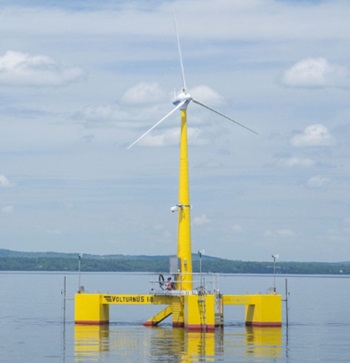 Below is my Executive Summary, followed by the latest bad news on this ongoing silly saga. This report examines several fundamental aspects of the State of Maine’s offshore wind development plan. It is divided into two parts. Part 1 examines certain economic issues, such as feasibility, cost, and progress to date. Part 2 explores the proposed development as it relates to the entire Gulf of Maine, namely because the project has not advanced to the point where the State of Maine’s responsibilities have been defined. The offshore wind plan calls for development of 3,000 MW of generating capacity, an amount that is roughly double Maine’s average electricity usage. The viability of Maine’s offshore wind plan depends entirely on the massive transformation of the state’s grid from fossil fuel use to electrification. It is clear that the citizens of Maine have not been informed of this vast transformation requirement. They have certainly not approved it. more, >>CLICK TO READ<< 09:34
Below is my Executive Summary, followed by the latest bad news on this ongoing silly saga. This report examines several fundamental aspects of the State of Maine’s offshore wind development plan. It is divided into two parts. Part 1 examines certain economic issues, such as feasibility, cost, and progress to date. Part 2 explores the proposed development as it relates to the entire Gulf of Maine, namely because the project has not advanced to the point where the State of Maine’s responsibilities have been defined. The offshore wind plan calls for development of 3,000 MW of generating capacity, an amount that is roughly double Maine’s average electricity usage. The viability of Maine’s offshore wind plan depends entirely on the massive transformation of the state’s grid from fossil fuel use to electrification. It is clear that the citizens of Maine have not been informed of this vast transformation requirement. They have certainly not approved it. more, >>CLICK TO READ<< 09:34
Thomas Elias: Gov. Newsom committing to big wind power projects risky right now
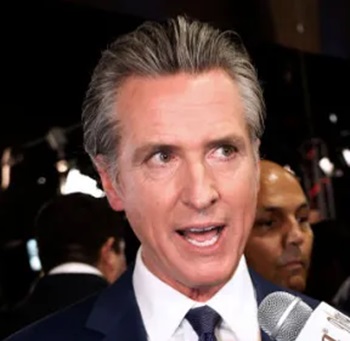 There weren’t many causes Gov. Gavin Newsom pushed harder during the just-concluded state legislative session than offshore wind power, something that has been tried in only a few places around America. For some in the California Legislature, including state Senate President Mike McGuire, D-Healdsburg, this seems an easy way to modernize the state’s electric grid without risking much pollution, taking advantage of an inexhaustible natural resource — winds that often gust at 40 mph or more. However, now it’s time for Newsom to go slow before committing California electric customers (who always pay for new generating facilities via their monthly bills) to fund this largely untried renewable energy source. If adopted, a plan to build enough offshore windmills to fill about 6% of California’s electric needs would be America’s largest commitment to offshore wind power. There is not yet any offshore wind power along the Pacific Coast, but yes, there is offshore wind power on the Atlantic Coast. There’s a small (five-turbine) project off Block Island, Rhode Island. Also, there are a few windmills off Virginia and others off Massachusetts’ Nantucket Island. more, >>CLICK TO READ<< 12:22
There weren’t many causes Gov. Gavin Newsom pushed harder during the just-concluded state legislative session than offshore wind power, something that has been tried in only a few places around America. For some in the California Legislature, including state Senate President Mike McGuire, D-Healdsburg, this seems an easy way to modernize the state’s electric grid without risking much pollution, taking advantage of an inexhaustible natural resource — winds that often gust at 40 mph or more. However, now it’s time for Newsom to go slow before committing California electric customers (who always pay for new generating facilities via their monthly bills) to fund this largely untried renewable energy source. If adopted, a plan to build enough offshore windmills to fill about 6% of California’s electric needs would be America’s largest commitment to offshore wind power. There is not yet any offshore wind power along the Pacific Coast, but yes, there is offshore wind power on the Atlantic Coast. There’s a small (five-turbine) project off Block Island, Rhode Island. Also, there are a few windmills off Virginia and others off Massachusetts’ Nantucket Island. more, >>CLICK TO READ<< 12:22
Why Is Cheap Wind Power So Expensive?
 Hmmm, sez I, seems a mite ambitious. Current US grid-connected offshore wind is a mere 0.17 gigawatts … so we’d need to do ~ 175 times as much as we’ve done to date and do it in a short six years. So, I divided it out. There are 65 months until 2030. Thirty gigawatts are thirty thousand megawatts, less the 174 megawatts in place, that’s 29,826 megawatts more total generating capacity needed. 29,826 megawatts divided by 65 months means we’d have to add offshore wind generation to the tune of 465 additional megawatts of generation capacity per month. Every month. Starting now. Get real. That’s not remotely possible. The biggest US offshore windfarm just came online, 132 MW capacity. To reach the White House goal, every month we’d need to build three new windfarms of that size. No way that can happen. It’s just numbers picked out of the air to gain popular support. more, >>CLICK TO READ<< 13:30
Hmmm, sez I, seems a mite ambitious. Current US grid-connected offshore wind is a mere 0.17 gigawatts … so we’d need to do ~ 175 times as much as we’ve done to date and do it in a short six years. So, I divided it out. There are 65 months until 2030. Thirty gigawatts are thirty thousand megawatts, less the 174 megawatts in place, that’s 29,826 megawatts more total generating capacity needed. 29,826 megawatts divided by 65 months means we’d have to add offshore wind generation to the tune of 465 additional megawatts of generation capacity per month. Every month. Starting now. Get real. That’s not remotely possible. The biggest US offshore windfarm just came online, 132 MW capacity. To reach the White House goal, every month we’d need to build three new windfarms of that size. No way that can happen. It’s just numbers picked out of the air to gain popular support. more, >>CLICK TO READ<< 13:30
Biden-Subsidized Offshore Wind Developer Reports Massive Losses in Latest Blow to Industry
 A Danish renewable energy group booked huge impairment losses Thursday after it pushed back the launch of one of its U.S. offshore wind projects, according to its first-half 2024 earnings report. Orsted estimated the value of its assets declined $472 million in the first half of 2024, largely due to delays at the onshore substation for its 704 megawatt (MW) “Revolution Wind” project off the coast of Rhode Island and Connecticut, the report showed. The company also reported a variety of other problems, including losses related to its cancellation of its Ocean Wind projects in New Jersey and its abandoned effort to produce eco-friendly methanol in Sweden. “Despite encouraging progress on our US offshore wind project Revolution Wind, the construction of the onshore substation for the project has been delayed,” Orsted’s CEO Mads Nipper said in reference to the delay. “This is, of course, unsatisfactory, and we continue our dedicated efforts to de-risk our portfolio.” more, >>CLICK TO READ<< 17:03
A Danish renewable energy group booked huge impairment losses Thursday after it pushed back the launch of one of its U.S. offshore wind projects, according to its first-half 2024 earnings report. Orsted estimated the value of its assets declined $472 million in the first half of 2024, largely due to delays at the onshore substation for its 704 megawatt (MW) “Revolution Wind” project off the coast of Rhode Island and Connecticut, the report showed. The company also reported a variety of other problems, including losses related to its cancellation of its Ocean Wind projects in New Jersey and its abandoned effort to produce eco-friendly methanol in Sweden. “Despite encouraging progress on our US offshore wind project Revolution Wind, the construction of the onshore substation for the project has been delayed,” Orsted’s CEO Mads Nipper said in reference to the delay. “This is, of course, unsatisfactory, and we continue our dedicated efforts to de-risk our portfolio.” more, >>CLICK TO READ<< 17:03
TX Fishing Industry Under Threat From BlackRock Wind Farm Project
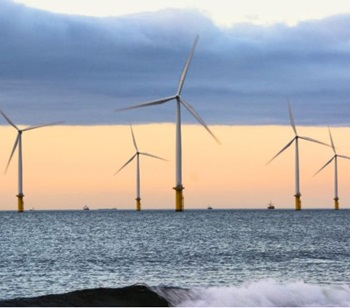 The massive destruction wrought on Massachusetts’ Vineyard Wind project has raised new questions about the safety and prudence of a similar BlackRock-backed project planned off the coasts of Louisiana and Texas near Port Arthur. Bonnie Brady of the Long Island Commercial Fisherman’s Association posted several pictures of broken and mangled offshore wind turbines from a recent storm to her X account on July 20. The images depict turbines with snapped blades hanging from their mounts. They also show large shards of metal and other debris washing ashore. Brady directed her post to every East Coast governor and the major presidential contenders, save for Vice President Kamala Harris, who had not yet announced her presidential candidacy, warning of what could happen to the fishing industry. “Stop the madness while you still can, because when the fiberglass lands on your shores you will (eventually) be out of the job. Ps we will never forget you threw US commercial fishing industries under the bus,” she wrote. more, >>CLICK TO READ<< 07:14
The massive destruction wrought on Massachusetts’ Vineyard Wind project has raised new questions about the safety and prudence of a similar BlackRock-backed project planned off the coasts of Louisiana and Texas near Port Arthur. Bonnie Brady of the Long Island Commercial Fisherman’s Association posted several pictures of broken and mangled offshore wind turbines from a recent storm to her X account on July 20. The images depict turbines with snapped blades hanging from their mounts. They also show large shards of metal and other debris washing ashore. Brady directed her post to every East Coast governor and the major presidential contenders, save for Vice President Kamala Harris, who had not yet announced her presidential candidacy, warning of what could happen to the fishing industry. “Stop the madness while you still can, because when the fiberglass lands on your shores you will (eventually) be out of the job. Ps we will never forget you threw US commercial fishing industries under the bus,” she wrote. more, >>CLICK TO READ<< 07:14
The Offshore Wind Energy Scandal Is Even Worse Than You Think
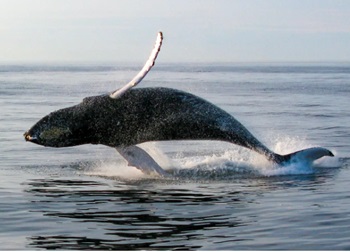 These 11 charts show how America’s biggest NGOs are colluding with foreign corporations that want to industrialize our oceans with thousands of turbines that will hurt whales and ratepayers Two of Europe’s biggest energy companies are abandoning the SS Offshore Wind. In May, Shell, the UK-based oil and gas giant (2023 revenue: $317 billion), announced that it was cutting staff from its offshore wind business because, according to Bloomberg, the company has decided to focus on markets that “deliver the most value for our investors and customers.” Bloomberg also reported that the staff cuts were made after the departures of top executives in the company’s offshore wind and renewable power businesses. Lots of informative grafs. more, >>CLICK TO READ<< 09:29
These 11 charts show how America’s biggest NGOs are colluding with foreign corporations that want to industrialize our oceans with thousands of turbines that will hurt whales and ratepayers Two of Europe’s biggest energy companies are abandoning the SS Offshore Wind. In May, Shell, the UK-based oil and gas giant (2023 revenue: $317 billion), announced that it was cutting staff from its offshore wind business because, according to Bloomberg, the company has decided to focus on markets that “deliver the most value for our investors and customers.” Bloomberg also reported that the staff cuts were made after the departures of top executives in the company’s offshore wind and renewable power businesses. Lots of informative grafs. more, >>CLICK TO READ<< 09:29
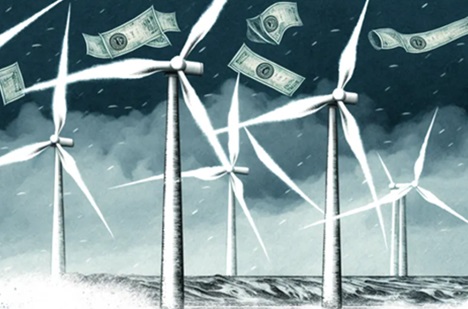
Vineyard Wind Turbine Failure: Incident Details, Regulatory Response, and Industry Implications
On July 13, 2024, an offshore wind turbine at the Vineyard Wind 1 project experienced a significant blade failure, leading to debris washing up on Nantucket’s beaches and prompting a federal shutdown of the wind farm. This incident raises obvious questions about the safety and reliability of offshore wind projects, as well as the regulatory framework governing this emerging industry. In the days following the incident, debris from the broken turbine blade began washing up on Nantucket’s south shore beaches. Residents reported finding pieces of green and white foam, along with larger pieces of fiberglass, stretching from Madaket to Nobadeer. In response to the incident, the federal Bureau of Safety and Environmental Enforcement (BSEE) ordered Vineyard Wind to shut down operations “until further notice”. The BSEE, which oversees offshore energy projects, sent a team of experts to work closely with Vineyard Wind on analyzing the cause of the incident and determining next steps. more, >>CLICK TO READ<< 07:22
Broken Offshore Wind Blade Debris Washes Up in Nantucket
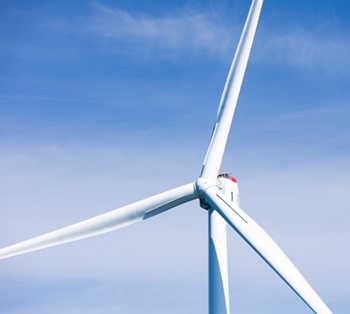 Investigators are probing the cause of a damaged offshore wind turbine blade that sent debris washing ashore at Nantucket Beach and shut down swimming in the area. The incident occurred Saturday evening at the 800-megawatt Vineyard Wind project under construction near Martha’s Vineyard, Massachusetts, prompting the probe by federal officials, developers Avangrid Inc. and Copenhagen Infrastructure Partners P/S, and GE Vernova Inc., which manufactured the Haliade-X turbines used at the site. Operations at the site have been suspended while investigations are underway, and authorities closed Nantucket’s south shore to swimming for three days. Photos, more, >>CLICK TO READ<< 08:46
Investigators are probing the cause of a damaged offshore wind turbine blade that sent debris washing ashore at Nantucket Beach and shut down swimming in the area. The incident occurred Saturday evening at the 800-megawatt Vineyard Wind project under construction near Martha’s Vineyard, Massachusetts, prompting the probe by federal officials, developers Avangrid Inc. and Copenhagen Infrastructure Partners P/S, and GE Vernova Inc., which manufactured the Haliade-X turbines used at the site. Operations at the site have been suspended while investigations are underway, and authorities closed Nantucket’s south shore to swimming for three days. Photos, more, >>CLICK TO READ<< 08:46
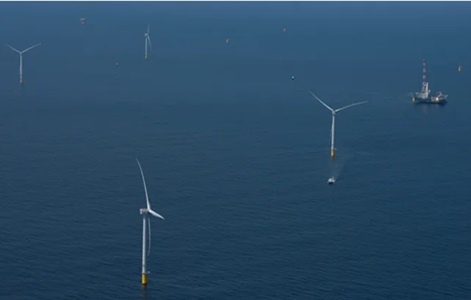
UPDATED: ‘Three large blade pieces.’ Vineyard Wind wind turbine blade snaps. Search underway
A blade on one of the Vineyard Wind 1 offshore turbines was damaged over the weekend, prompting an investigation by the blade’s manufacturer. In a statement released Monday afternoon, the offshore wind developer referred only to “an incident involving blade damage on a wind turbine” in the offshore energy area south of Martha’s Vineyard. According to the company, the undisclosed damage happened on Saturday evening. No employees, contractors or fishing vessels were in the vicinity of the turbine at the time. No details were given as to the nature of the damage, how long the blade has been in place, or whether it was on an already operating turbine or one under construction. more, >>CLICK TO READ<< 11:45
Warning of Potential Conflict Between Fishing Industry and Energy Developers
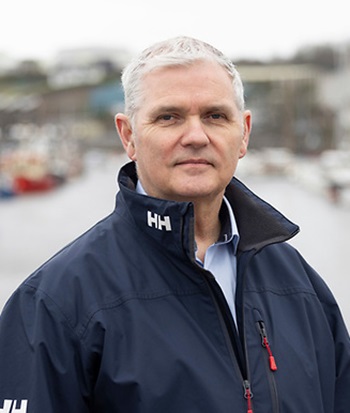 There is a potential for conflict between fishermen and the ‘blue economy’ strategists, according to one of the leading figures in the fishing industry. The fishing industry says that it supports the need for climate change, but it is being claimed that it is being “squeezed out” of traditional fishing grounds and that the role of the industry as a food supplier is not being understood by Government, offshore renewable energy developers or environmentalists. The Chief Executive of the Irish Fish Producers’ Organisation, Aodh O Donnell, has now warned of potential conflict and that there is a commercial motive of exporting power outside Ireland, while fishing operations and practices could be closed. more, >>CLICK TO READ<< 07:38
There is a potential for conflict between fishermen and the ‘blue economy’ strategists, according to one of the leading figures in the fishing industry. The fishing industry says that it supports the need for climate change, but it is being claimed that it is being “squeezed out” of traditional fishing grounds and that the role of the industry as a food supplier is not being understood by Government, offshore renewable energy developers or environmentalists. The Chief Executive of the Irish Fish Producers’ Organisation, Aodh O Donnell, has now warned of potential conflict and that there is a commercial motive of exporting power outside Ireland, while fishing operations and practices could be closed. more, >>CLICK TO READ<< 07:38
Governor urged to use ‘Oregon way’ in ocean wind energy development
 Oregon’s state seafood commodity commissions have expressed their concerns in a letter to Kotek over federal offshore wind energy development plans proposed for the southern Oregon coast. The letter emphasizes what the commission states are adverse effects on the ocean environment and Oregon’s sustainable seafood industry. Oregon Trawl, Oregon Dungeness Crab, Oregon Albacore and Oregon Salmon Commissions urged Kotek to prioritize Oregon’s own planning process under the auspices of the state official “Roadmap” initiative, intended to guide responsible offshore wind energy development in Oregon. The Oregon groups opposing the development said the offshore wind facilities will be built in the pristine ocean ecosystems that support remarkable marine biodiversity, including many protected species. No environmental studies have been performed to assess the risks of large-scale offshore wind energy production which risks overwhelming this unique remote ocean region, according to the opponents. more, >>CLICK TO READ<< 09:32
Oregon’s state seafood commodity commissions have expressed their concerns in a letter to Kotek over federal offshore wind energy development plans proposed for the southern Oregon coast. The letter emphasizes what the commission states are adverse effects on the ocean environment and Oregon’s sustainable seafood industry. Oregon Trawl, Oregon Dungeness Crab, Oregon Albacore and Oregon Salmon Commissions urged Kotek to prioritize Oregon’s own planning process under the auspices of the state official “Roadmap” initiative, intended to guide responsible offshore wind energy development in Oregon. The Oregon groups opposing the development said the offshore wind facilities will be built in the pristine ocean ecosystems that support remarkable marine biodiversity, including many protected species. No environmental studies have been performed to assess the risks of large-scale offshore wind energy production which risks overwhelming this unique remote ocean region, according to the opponents. more, >>CLICK TO READ<< 09:32
Floating Wind Madness in Maine
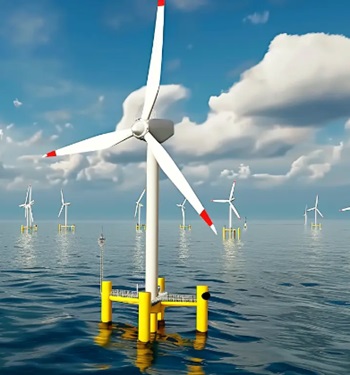 The Government of Maine has really big plans for floating wind, a floating net zero fantasy, in fact. Since floating wind power is the next big green thing, it is worth taking a close look at this ruinous vision. Floating wind is a fad, not an established technology. It has yet to be built at utility scale or tested in a hurricane. The world’s biggest grid-connected system is a tiny 50 MW and just came online off Scotland. The cost of floating wind is necessarily much greater than fixed wind. A fixed wind tower sits on a simple monopile, while a floating tower sits on a huge complex structure called a floater. We are talking about massive 500-foot towers with 500-ton turbines on top and 300-foot blades catching the wind. more, >>CLICK TO READ<< 06:17
The Government of Maine has really big plans for floating wind, a floating net zero fantasy, in fact. Since floating wind power is the next big green thing, it is worth taking a close look at this ruinous vision. Floating wind is a fad, not an established technology. It has yet to be built at utility scale or tested in a hurricane. The world’s biggest grid-connected system is a tiny 50 MW and just came online off Scotland. The cost of floating wind is necessarily much greater than fixed wind. A fixed wind tower sits on a simple monopile, while a floating tower sits on a huge complex structure called a floater. We are talking about massive 500-foot towers with 500-ton turbines on top and 300-foot blades catching the wind. more, >>CLICK TO READ<< 06:17
Frank Lasee: Wind Turbines and Lobsters Mean Less Lobsters and Not Enough Electricity
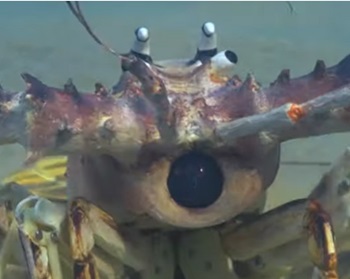 National Lobster Day is a good time to think about what the expensive, subsidized offshore wind development is going to do to lobsters and the $400 million lobster industry. Offshore wind will disrupt fishing for them and harm their habitat. This is not good for the Maine lobsters, and it is not good for electric affordability either. The 30 gigawatts (GW) of offshore wind ordered by President Joe Biden–not Congress–is catering to the far left of the Democrat Party’s base. Over 2,000 wind turbines and foundations, 6,800 miles of cable and hundreds of specialist vessels are needed to deploy 30 GW, according to the Department of Energy. The offshore wind industry spent $2.7 billion in supply chain, transmission, ports and boats in the first year of operation. Their costs have only begun. Electricity rates are going up wherever they add offshore wind electricity generation. more, >>CLICK TO READ<< 10:30
National Lobster Day is a good time to think about what the expensive, subsidized offshore wind development is going to do to lobsters and the $400 million lobster industry. Offshore wind will disrupt fishing for them and harm their habitat. This is not good for the Maine lobsters, and it is not good for electric affordability either. The 30 gigawatts (GW) of offshore wind ordered by President Joe Biden–not Congress–is catering to the far left of the Democrat Party’s base. Over 2,000 wind turbines and foundations, 6,800 miles of cable and hundreds of specialist vessels are needed to deploy 30 GW, according to the Department of Energy. The offshore wind industry spent $2.7 billion in supply chain, transmission, ports and boats in the first year of operation. Their costs have only begun. Electricity rates are going up wherever they add offshore wind electricity generation. more, >>CLICK TO READ<< 10:30
United States Navy testing wind-turbine powered aircraft carriers
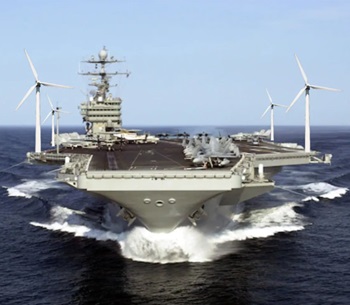 The United States Navy is currently testing aircraft carriers powered solely by wind turbines announced Secretary of the Navy Carlos Del Toro during a recent appearance at the US Naval Academy. The Secretary proudly spoke to the Midshipmen about the historic change. “We are embarking in a bold green direction, transitioning from the aging nuclear reactors of yesterday to the efficient use of sustainable wind energy, something we’ve never done before!” “The USS Al Gore will be complete with testing in late 2024. Initial testing has revealed a substantial decrease in speed which has only made the already dangerous take-off and landing exponentially more so. more, >>CLICK TO READ<< 09:53
The United States Navy is currently testing aircraft carriers powered solely by wind turbines announced Secretary of the Navy Carlos Del Toro during a recent appearance at the US Naval Academy. The Secretary proudly spoke to the Midshipmen about the historic change. “We are embarking in a bold green direction, transitioning from the aging nuclear reactors of yesterday to the efficient use of sustainable wind energy, something we’ve never done before!” “The USS Al Gore will be complete with testing in late 2024. Initial testing has revealed a substantial decrease in speed which has only made the already dangerous take-off and landing exponentially more so. more, >>CLICK TO READ<< 09:53
Offshore Wind Cumulative Impact Issue Analysis
 When the Feds finally do the cumulative environmental impact analysis for whales as mandated by the Endangered Species Act there are a number of basic issues to be resolved. Here is a quick look at some for the desperately endangered North Atlantic Right Whale (NARW). Cumulative refers to the combined impact of multiple offshore projects. The first issue is which projects to combine for analysis. NARW are found along the entire Atlantic coastal waters which bounds the geography. Other endangered critters are found along the Gulf and West Coasts. Projects can be in very different stages of development. Here is a hierarchy of sorts that gives several obvious options, from relatively small to enormous. more, >>CLICK TO READ<< 09:07
When the Feds finally do the cumulative environmental impact analysis for whales as mandated by the Endangered Species Act there are a number of basic issues to be resolved. Here is a quick look at some for the desperately endangered North Atlantic Right Whale (NARW). Cumulative refers to the combined impact of multiple offshore projects. The first issue is which projects to combine for analysis. NARW are found along the entire Atlantic coastal waters which bounds the geography. Other endangered critters are found along the Gulf and West Coasts. Projects can be in very different stages of development. Here is a hierarchy of sorts that gives several obvious options, from relatively small to enormous. more, >>CLICK TO READ<< 09:07
Feds announce areas where offshore wind can go in Gulf of Maine
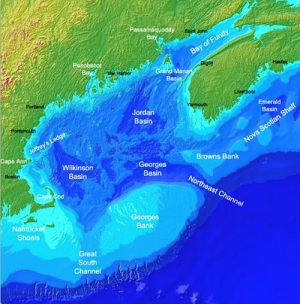 Federal regulators have made a final designation of roughly 2 million acres in the Gulf of Maine where offshore wind turbines can be deployed to help provide power to New England. The boundary set by the Bureau of Ocean Energy Management does not include any part of the federal lobster management area 1. That fishing area extends from state waters about three miles offshore to about 40 miles. The closest the designated federal wind energy area comes to Maine’s coast is just outside the fishing zone. The Maine Lobstermen’s Association said Friday that it appreciates that the fishing zone is excluded from the wind area approved by BOEM. But it said that it remains “steadfast” in its position that industrial wind power development does not belong anywhere in the Gulf of Maine. more, >>click to read<< 12:39
Federal regulators have made a final designation of roughly 2 million acres in the Gulf of Maine where offshore wind turbines can be deployed to help provide power to New England. The boundary set by the Bureau of Ocean Energy Management does not include any part of the federal lobster management area 1. That fishing area extends from state waters about three miles offshore to about 40 miles. The closest the designated federal wind energy area comes to Maine’s coast is just outside the fishing zone. The Maine Lobstermen’s Association said Friday that it appreciates that the fishing zone is excluded from the wind area approved by BOEM. But it said that it remains “steadfast” in its position that industrial wind power development does not belong anywhere in the Gulf of Maine. more, >>click to read<< 12:39
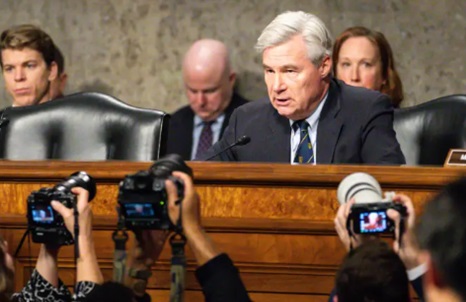
Sen. Sheldon Whitehouse backed laws to benefit wife’s company and their ‘financial interests’: ethics complaint
Democratic Sen. Sheldon Whitehouse, a crusader for new ethics guidelines at the Supreme Court, was himself hit with an ethics complaint last month after backing two dozen pieces of legislation that have benefited his wife’s environmental consulting company. Whitehouse, 68, has been dogged by ethics questions since his first years in the Senate, when he secured a $22 million federal grant for an offshore wind company, Deepwater Wind, that had hired his wife as a “permitting consultant,” the complaint states, citing contemporaneous reports from local Rhode Island outlets. Sandra Thornton Whitehouse is currently the president of Newport, RI-based, for-profit consulting firm Ocean Wonks, LLC, raking in millions of dollars for her work with non-profit clients that profited from her husband’s legislative activity. Video, photos, more, >>click to read<< 06:42
Environmentalists face off against environmentalists over offshore wind projects
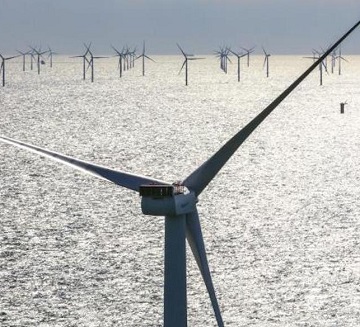 The Energy Department estimates offshore wind turbines could produce as much as 20% of regional power needs along the densely populated Eastern Seaboard from Florida to Maine by 2050. To reach that goal, the Biden administration had hoped to green-light 30 gigawatts from utility-scale offshore wind farms by 2030—enough to power nine million homes. That now seems wildly ambitious, as billions of dollars in projects have been canceled amid staggering cost overruns, soaring interest rates and supply-chain delays. Added to these economic woes are persistent environmental concerns, as attested to by some recent federal lawsuits. In September, for example, Cape May County, N.J., and a coalition of regional environmental, fisheries and tourism groups sought to stop development of two utility-scale projects off the New Jersey coast. more, >>click to read<< 11:54
The Energy Department estimates offshore wind turbines could produce as much as 20% of regional power needs along the densely populated Eastern Seaboard from Florida to Maine by 2050. To reach that goal, the Biden administration had hoped to green-light 30 gigawatts from utility-scale offshore wind farms by 2030—enough to power nine million homes. That now seems wildly ambitious, as billions of dollars in projects have been canceled amid staggering cost overruns, soaring interest rates and supply-chain delays. Added to these economic woes are persistent environmental concerns, as attested to by some recent federal lawsuits. In September, for example, Cape May County, N.J., and a coalition of regional environmental, fisheries and tourism groups sought to stop development of two utility-scale projects off the New Jersey coast. more, >>click to read<< 11:54
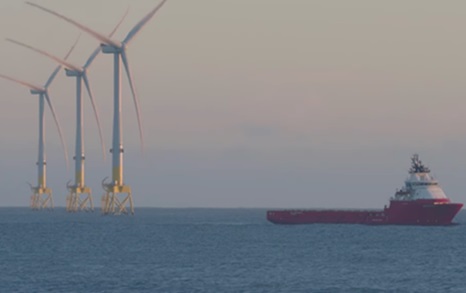
Ringside View: Offshore Wind is a Financial and Environmental Catastrophe
It’s about time Californians of all ideological persuasions wake up and stop what is possibly the most economically wasteful and environmentally destructive project in American history: the utility scale adoption of offshore wind energy. The California Legislature intends to despoil our coastline and coastal waters with floating wind turbines, 20+ miles offshore, tethered to the sea floor 4,000 feet beneath the waves. Along with tethering cables, high voltage wires will descend from each of these noisy, 1,000 foot tall leviathans, but we’re to assume none of this will disrupt the migrations of our treasured Cetaceans and other marine and avian life, not the electric fields emanating from hundreds (thousands?) of 20+ mile long live power lines laid onto the ocean floor, nor from the construction, the maintenance, or the new ports, ships, and submersibles. >>click to reafd<< 10:57

New York Rejects Offshore Wind’s Request to Raise Rates
Offshore wind developers are reevaluating some New York projects after regulators rejected higher rates by Equinor ASA, Orsted A/S and others that would have added as much as $12 billion in costs. Developers planning to build more than 4 gigawatts of wind-power capacity off Long Island must abide by existing contracts to deliver power, the New York Public Service Commission unanimously ruled during a meeting Thursday. The ruling is the latest blow to the US offshore wind industry already contending with inflation and supply-chain issues. The future of projects such as Orsted’s Sunrise Wind is now in question after Thursday’s decision. >>click to read<< 17:06






